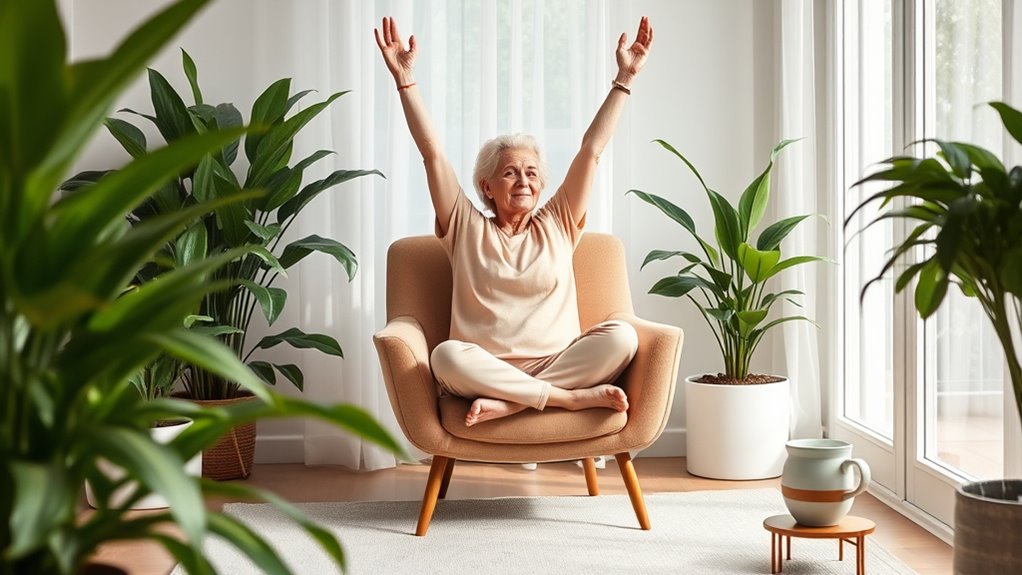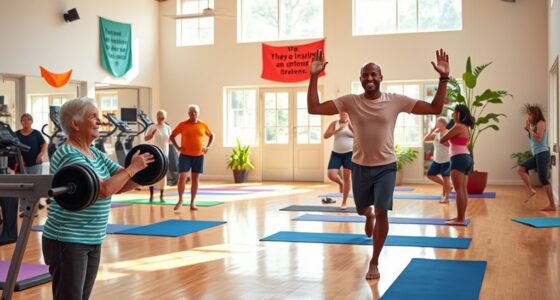Chair yoga is a fantastic way for you to stretch and relax in just minutes. It’s safe and accessible, making it perfect for seniors. You’ll improve flexibility, reduce joint pain, and boost your mental well-being. Start by finding a sturdy chair and getting comfortable. Warm up with deep breathing and gentle upper body stretches. Incorporate forward bends and twists to enhance mobility. With a regular chair yoga routine, you’ll feel more at ease in your daily activities. Discover more effective techniques to enhance your practice.
Key Takeaways
- Chair yoga is a safe and accessible practice that enhances flexibility and reduces joint pain for seniors.
- Simple warm-up techniques, like deep breathing and gentle torso undulations, promote relaxation and prepare the body for movement.
- Incorporate upper body stretches, such as shoulder rolls and wrist circles, to improve range of motion and alleviate tension.
- Forward bends and seated twists can help release stress while enhancing spinal flexibility and core engagement.
- Conclude with gentle cool-down practices, including ankle circles and neck stretches, to promote relaxation and reflect on the experience.
The Benefits of Chair Yoga for Seniors
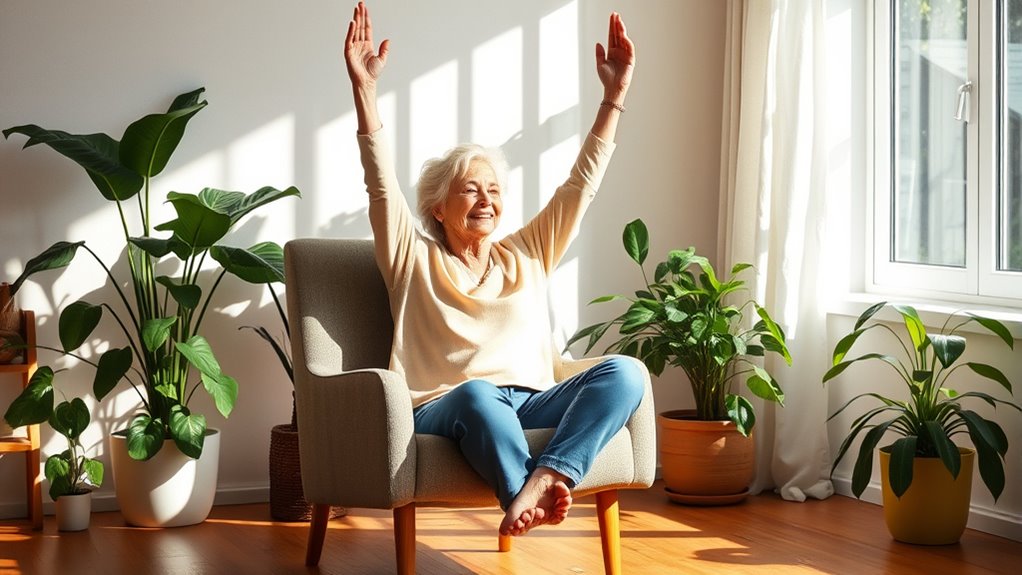
Chair yoga offers a safe and accessible way for seniors to stay active, even if standing or extensive physical strain isn’t possible. This gentle practice promotes improved flexibility and mobility, which can greatly reduce joint pain and stiffness, especially for those with arthritis. Engaging in visualization techniques during chair yoga can help seniors focus on their desired outcomes, enhancing their overall experience. Additionally, regular participation in chair yoga can foster self-care practices, allowing seniors to prioritize their health and well-being. Incorporating good grief strategies into chair yoga can also provide emotional support for those dealing with loss. Practicing self-care through activities like chair yoga can also help combat toxic relationships, promoting healthier connections with others.
As you engage in chair yoga, the gentle movements enhance circulation, benefiting your cardiovascular health. Additionally, chair yoga isn’t just about physical benefits; it’s also a powerful tool for improving mental well-being. By reducing stress and anxiety, it can elevate your mood and boost cognitive function. Plus, participating in chair yoga encourages social interaction, helping to combat feelings of isolation.
Engaging in mindfulness practices during chair yoga can further enhance your self-awareness and overall well-being.
Embrace chair yoga, and enjoy its multifaceted benefits for both body and mind!
Preparing for Your Chair Yoga Session
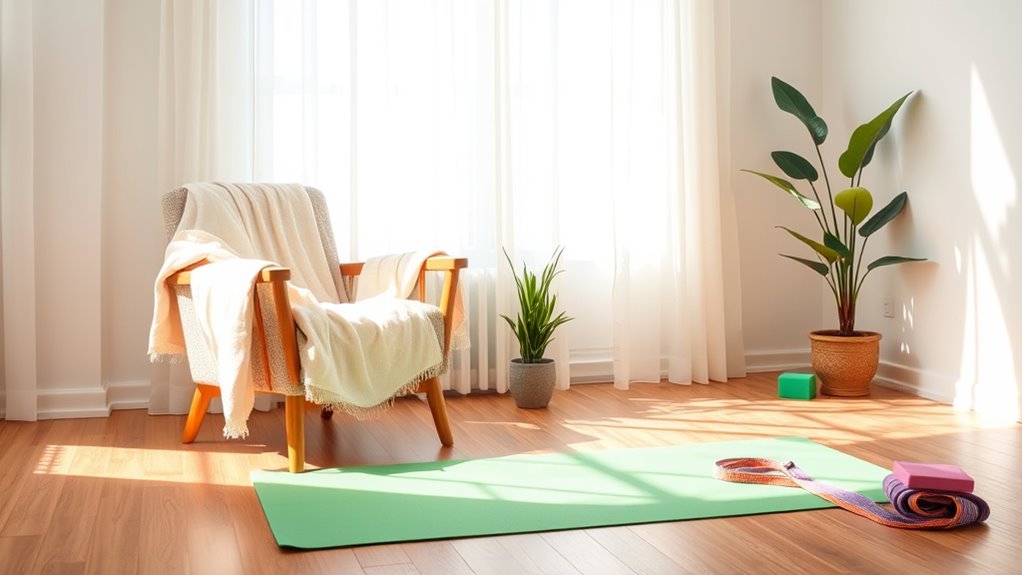
To get the most out of your chair yoga session, start by finding a comfortable chair that offers good support.
Arrange your space to minimize distractions, so you can focus on your practice. Regular cleaning of air purifiers in your space can further enhance your relaxation by ensuring cleaner air quality. Additionally, using an air purifier with HEPA filters can help capture airborne particles, contributing to a healthier environment for your yoga practice. Maintaining proper airflow around your air purifier will also improve its performance, allowing for a more refreshing atmosphere. Consider also the importance of proper toilet maintenance to prevent any unnecessary interruptions during your session. Incorporating smart capabilities in your air purifier can enhance your experience by allowing for remote operation and monitoring of air quality.
Find a Comfortable Chair
Finding the right chair is essential for a successful chair yoga session.
Choose a sturdy chair without arms to allow a full range of motion during your stretches. It’s important that the chair’s height lets your feet rest flat on the ground for maximum stability and support. Look for one with a comfortable cushion to provide adequate support, especially during longer sessions. To enhance your practice, consider using a chair made from natural materials to create a more calming environment. Additionally, using a chair with ergonomic design can help promote better posture during your practice. Many hotels with water parks offer relaxing environments that can inspire mindfulness and relaxation. Creating your own greenhouse can also provide an ideal space for relaxation and mindfulness.
Position your chair in a quiet space with plenty of room to move freely around it, minimizing distractions while you practice. For added safety, especially if you have balance concerns, place the chair against a wall or another sturdy object. This way, you can focus on your yoga without worrying about stability. Additionally, consider incorporating essential oils for relaxation to enhance your overall experience during chair yoga.
Set Up Your Space
Creating a serene environment for your chair yoga session can greatly enhance your experience. To set up your space effectively, follow these steps:
- Choose a sturdy, armless chair with a straight back to help you sit nice and tall and maintain proper posture. This will also promote optimal performance during your exercises. Additionally, ensuring that your chair is placed in a well-lit area can enhance visual clarity and help you focus better on your movements.
- Select a quiet area free from distractions, allowing you to focus and relax during your practice. Maintaining a clean environment is essential for both mental clarity and relaxation. Additionally, reducing exposure to harmful pollutants can create a healthier atmosphere for your practice.
- Place your chair on a flat, non-slippery surface to prevent any accidents while stretching or moving, particularly with your back knee.
- Keep a water bottle nearby to stay hydrated and take breaks as needed, ensuring your comfort throughout the session.
These simple steps can create an inviting atmosphere for a successful chair yoga experience. Additionally, incorporating elements of nature-inspired designs can further promote tranquility and enhance your well-being during the practice.
Gentle Warm-Up Techniques

Starting your chair yoga session with gentle warm-up techniques is essential for preparing your body and mind. Begin by taking a deep breath in and exhaling slowly to promote relaxation. Make sure to engage your core by tilting your pelvis forward and back, incorporating gentle cat-cow movements to warm up your spine. Additionally, practicing deep breathing can help calm the mind and enhance your focus during the session. Incorporating these practices can also lead to improved emotional regulation, which is crucial for overall mental health. Engaging in mindful movements can also reduce stress levels, allowing for a more tranquil yoga experience. Including activities that promote creative expression can further enhance the benefits of your practice.
| Warm-Up Technique | Benefits |
|---|---|
| Deep Breathing | Promotes relaxation |
| Pelvic Tilts | Engages core, warms spine |
| Torso Undulations | Improves spinal mobility |
| Seated Body Rolls | Increases blood flow |
| Breath Control | Enhances workout effectiveness |
These warm-ups set a solid foundation for your chair yoga practice, especially beneficial for seniors and those with joint issues. Additionally, incorporating self-love into your routine can further enhance your overall well-being and relaxation.
Upper Body and Spine Stretches
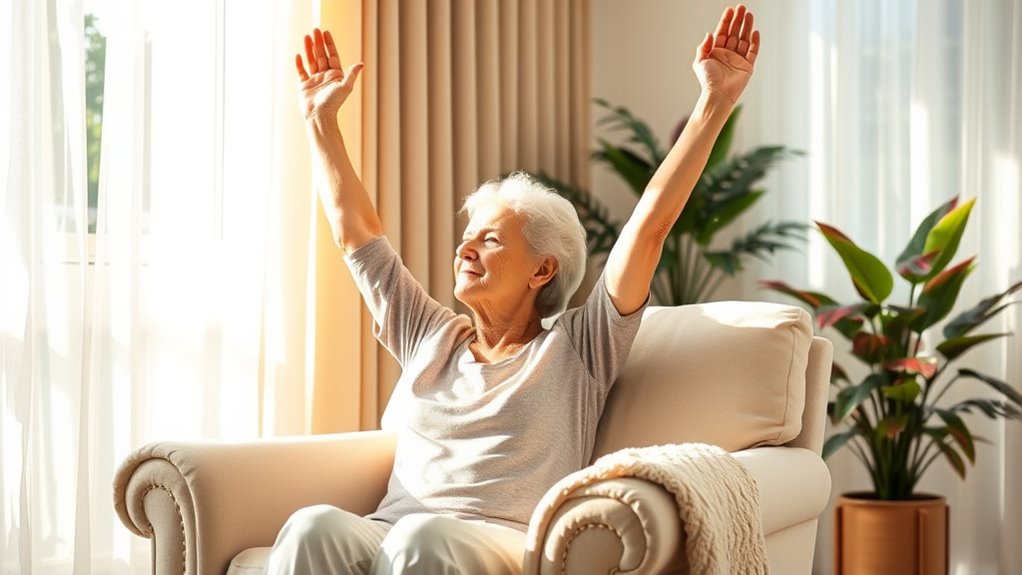
Now it’s time to focus on effective wrist stretches and engaging shoulder movements.
By incorporating these stretches, you can enhance flexibility and reduce tension in your upper body.
Let’s explore how these simple exercises can improve your overall comfort and mobility in daily activities. Additionally, practicing yoga can also help improve your color accuracy and awareness of body alignment, similar to how color accuracy impacts overall image quality in projectors.
Effective Wrist Stretches
While you may not realize it, wrist stretches play an essential role in enhancing flexibility and reducing tension in your upper body, especially as you age.
Here are some effective wrist stretches you can do while seated:
- Finger Flex: Extend your arm, palms facing up, and gently pull back on your fingers with your other hand, making sure to hold for a few breaths.
- Wrist Circles: Rotate your wrists in circular motions, first clockwise and then counterclockwise, to improve mobility.
- Wrist Flexion: With palms facing up, bend your wrists downward, holding for a few moments to feel the stretch.
- Finger Stretch: Spread your fingers wide and then bring them back together to relieve tension.
Incorporating these stretches regularly can greatly improve flexibility and comfort.
Engaging Shoulder Movements
Engaging in shoulder movements during chair yoga not only enhances flexibility but also encourages relaxation throughout the upper body.
Start with shoulder rolls, gently lifting your shoulders toward your ears and rolling them back and down. This simple motion releases tension and improves mobility.
Next, raise your arms overhead and bring your hands together in a prayer position, feeling the stretch across your shoulders.
Shift into side stretches by reaching one arm overhead while leaning to the opposite side, promoting lateral flexibility.
For a deeper stretch, try the eagle pose by crossing your arms and pressing your palms together, targeting the upper back.
Incorporating these movements helps ease discomfort and fosters a sense of calm throughout your practice.
Forward Bends, Twists, and Leg Stretches
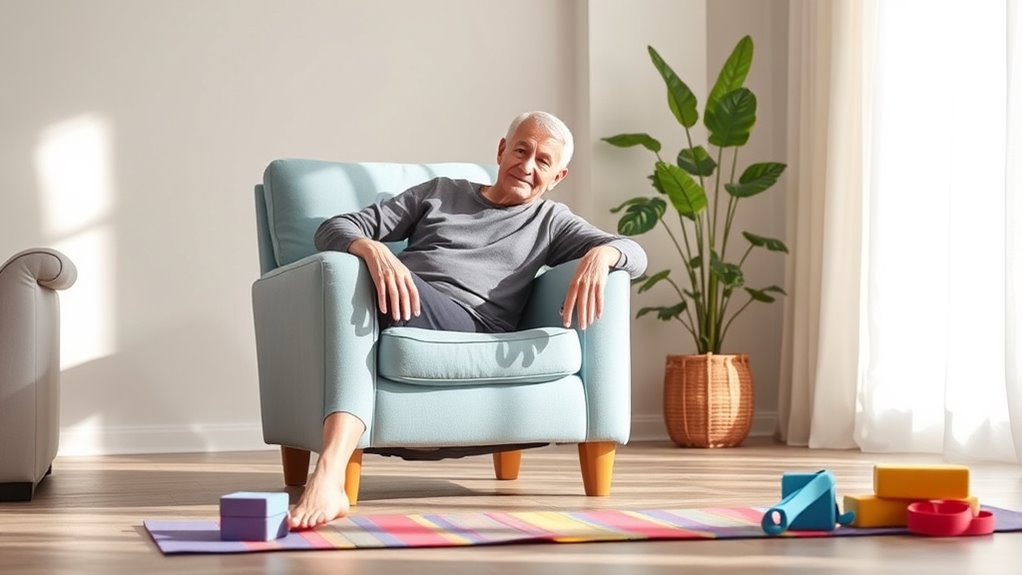
Chair yoga offers a wonderful way to incorporate forward bends, twists, and leg stretches into your routine, enhancing flexibility and relaxation.
Chair yoga is a fantastic method to improve flexibility and relaxation through gentle forward bends, twists, and leg stretches.
Here are some simple techniques to try:
- Forward Bends: Hinge forward from your hips with a flat back, letting your head drop to release tension in your neck and back.
- Seated Twists: Gently rotate your torso while breathing deeply, enhancing spinal flexibility and promoting relaxation.
- Leg Stretches: Extend one leg straight, inhale while raising your arms overhead, then exhale and reach toward your extended leg to deepen the stretch.
- Engage the Core: Bring your elbows toward the knee of the extended leg to perform a twisting motion, improving balance and core strength.
Repeat the sequence on the opposite leg to maintain symmetry and balance in flexibility.
Cool Down and Mindfulness Practices

After enjoying the benefits of forward bends, twists, and leg stretches, it’s important to wind down your practice with cool down and mindfulness techniques. Gentle shoulder twists and forward folds promote relaxation and reduce tension. Pair these movements with mindfulness practices that connect your breath with each motion, enhancing your overall calm.
Here’s a simple table to guide your cool down:
| Exercise | Purpose | Tips |
|---|---|---|
| Ankle Circles | Alleviate stiffness | Move slowly and gently |
| Neck Stretches | Improve flexibility | Keep shoulders relaxed |
| Shoulder Twists | Release tension | Breathe deeply |
| Forward Folds | Promote relaxation | Focus on your breath |
Express gratitude at the end of your session, reflecting on your experience to foster mental well-being.
Building a Regular Chair Yoga Routine
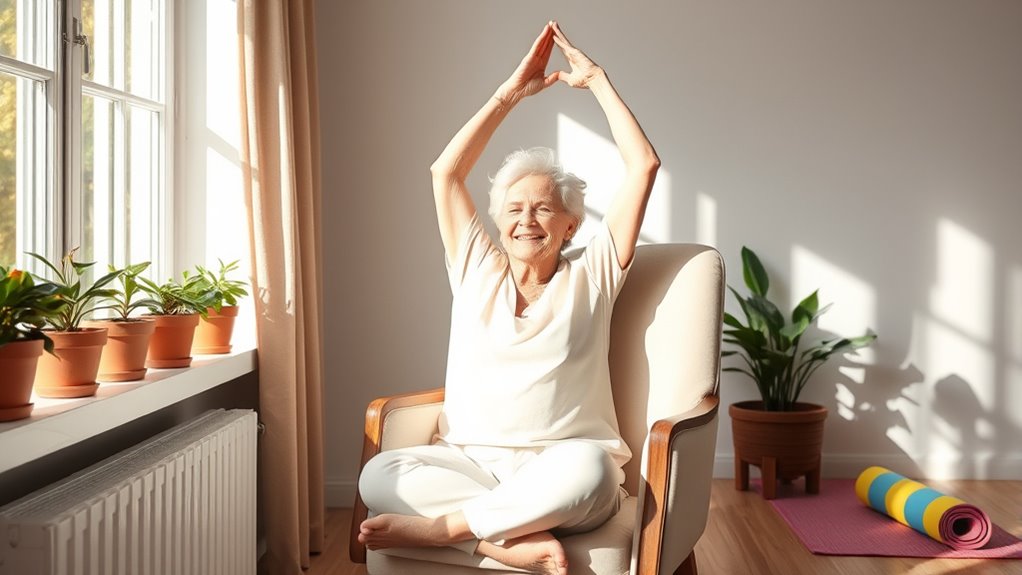
While establishing a regular yoga practice can be challenging, committing to chair yoga just a few times a week can greatly enhance your flexibility and strength.
To create a routine that works for you, consider these steps:
- Schedule: Aim for at least 2-3 sessions weekly to build consistency.
- Warm-Up: Start each session with deep breathing and gentle stretches to prepare your body.
- Variety: Incorporate upper body, spine, and leg stretches to target different muscle groups.
- Resources: Use online videos or community classes for motivation and a sense of connection.
As you progress, sit back and track your achievements.
Celebrate small milestones, and we’ll see how your commitment transforms your practice over time!
Frequently Asked Questions
Does Chair Yoga for Seniors Really Work?
Yes, chair yoga for seniors really works! You’ll notice improvements in flexibility, strength, and balance, which can help reduce your risk of falls.
Many participants report lower stress and anxiety levels, boosting your mental well-being. If you deal with joint pain or arthritis, you might find relief through regular practice.
Plus, you’ll enhance your breathing and mood, leading to greater emotional resilience and improved cognitive function. It’s a fantastic way to stay active!
Can You Lose Weight Doing Chair Yoga for Seniors?
Sure, chair yoga can be a surprisingly supportive solution for shedding those stubborn pounds!
While it mightn’t burn massive calories, you’ll gently gain strength and flexibility, boosting your daily activities.
Regular practice can also help ease stress, which often leads to weight gain.
By pairing chair yoga with a balanced diet, you’re setting yourself up for sustainable success.
Which Yoga Is Best for Senior Beginners?
If you’re a senior beginner, gentle yoga styles like Hatha or restorative yoga might be your best bet.
These practices focus on slow movements, deep breathing, and relaxation, making them perfect for easing into yoga.
Chair yoga is also an excellent option since it allows you to stretch and strengthen while seated, reducing fall risks.
How Often Should Seniors Do Chair Yoga?
You should aim to practice chair yoga at least 2-3 times a week to see real improvements in flexibility and balance.
Even short sessions of 15-30 minutes can help enhance your joint mobility and reduce tension.
Pay attention to how your body feels and adjust your practice based on your comfort.
Incorporating chair yoga into your daily routine can make it easier to stay active without feeling overwhelmed.
Conclusion
Incorporating chair yoga into your daily routine isn’t just about stretching; it’s a pathway to rejuvenation and peace. Imagine feeling lighter, both in body and spirit, as you flow through these gentle movements. By making time for these practices, you’re not only enhancing your flexibility but also nurturing your mind. So, why not embrace this simple yet transformative journey? Each session brings you closer to a healthier, happier you—one breath at a time.
